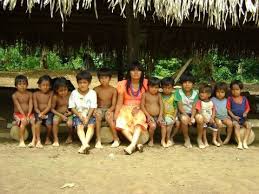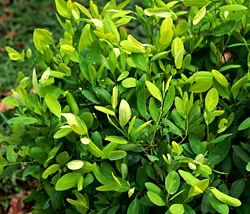The Candoshi People
 They live at Lake Rimachi which is the largest lake in the Amazon Basin.The Candoshi people depend upon the lake for their day-to-day survival.As fishing is crucial to the long-term survival of the Candoshi and their natural resources,WWF, together with the local government,are trying to improve their livelihood of their communities by linking them directly to markets to sell their fish.Thus,they will be able to avoid middlemen and take home more income.
They live at Lake Rimachi which is the largest lake in the Amazon Basin.The Candoshi people depend upon the lake for their day-to-day survival.As fishing is crucial to the long-term survival of the Candoshi and their natural resources,WWF, together with the local government,are trying to improve their livelihood of their communities by linking them directly to markets to sell their fish.Thus,they will be able to avoid middlemen and take home more income.
Amer-Indian people
 At one time almost 10 million native Indians occupied the lands of the South America Rainforest. But when Western and European explorers and conquistadors invaded the land in search of untold riches, there were less than one million indigenous people, today there are less than 250,000 indigenous natives.As the rainforest dies,so does the heritage of the land and sadly so do the people of the Rainforest.
At one time almost 10 million native Indians occupied the lands of the South America Rainforest. But when Western and European explorers and conquistadors invaded the land in search of untold riches, there were less than one million indigenous people, today there are less than 250,000 indigenous natives.As the rainforest dies,so does the heritage of the land and sadly so do the people of the Rainforest.
The remarkable human diversity here has over 215 ethnic groups speaking 170 different languages in an area composing 190 million acres of land. 188 million acres of this land remains inside the Brazilian Amazon, in the states of Acre, Amapa, Amazonas, Maranhao, Mato Grosso, Para, Rondonia, Roraima, and Tocantins.
Of these varying Amer-Indian people living in the Amazon Rainforest, one of the largest groups is the Yanomami. Village activity revolves around the main house which has multiple living quarters built in the center.
Pygmy Tribes, include Baka and Mbuti Pygmies, like the Bushmen of the Kalahari in Africa,are some of the last remaining "hunter-gathers".The Huli Indian Tribe are one of many who make their home in the remote highland forests of Papua New Guinea.
The people of the Amazon are highly intelligent, even though many have never seen any modern technology.They look between the land and the sky for signs of the seasons, celestial activity, planting times, weather and warnings of danger.
It is an amazing fact to realize it is estimated that as many as 50 indigenous tribal groups live so far in the depths of the Rainforest they have not yet made any contact with the outside .
 Bromeliad
Bromeliad


 White Trillium
White Trillium
 At one time almost 10 million native Indians occupied the lands of the South America Rainforest. But when Western and European explorers and conquistadors invaded the land in search of untold riches, there were less than one million indigenous people, today there are less than 250,000 indigenous natives.As the rainforest dies,so does the heritage of the land and sadly so do the people of the Rainforest.
At one time almost 10 million native Indians occupied the lands of the South America Rainforest. But when Western and European explorers and conquistadors invaded the land in search of untold riches, there were less than one million indigenous people, today there are less than 250,000 indigenous natives.As the rainforest dies,so does the heritage of the land and sadly so do the people of the Rainforest.